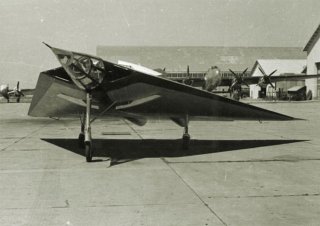Designed by A Nazi, Built in Argentina: Meet the I.Ae. 37 Jet Fighter
Known for building the world’s first jet-powered flying wing design, Reimar Horton of World War II fame tried his hand at the design again—but this time not for Germany.
The German Horton brothers, Reimar and Walter, were amateur airplane designers and flight enthusiasts. During Europe’s inter-war years, they came to prominence in Germany for their involvement in the country’s glider scene. After the First World War, Germany had been limited in what kinds and numbers of planes they were allowed to build. Gilders, however, were not restricted by the terms of the Treaty of Versailles, which ended the war.
Glider clubs became the training ground for the budding pre-war German air force—and the Horton brothers’ designs excelled. They marched to the beat of a different drummer and were known for building rather unconventional designs.
One of their most famous gliders—of which there were many—was a flying wing. Wide and relatively thick wings supported a small central fuselage in which the pilot would lay prone. Interestingly, their glider designs lacked any tail. This tailless design gave their gliders very little drag. Perhaps their most famous design, the Horten Ho 229, was the world’s first jet-powered flying wing airplane. Though the design never left the prototype stage, one of the brothers tried his hand at a similar design, this time overseas.
Overseas
After the Second World War, a number of prominent Nazis sought refuge overseas, sometimes in Latin America. Reimar Horton was one of these. Building upon the brothers’ glider and flying wing success, Reimar tried his hand at another flying wing design—but this time for Argentina.
Like the Horton brothers’ other prototypes, initial models were made of wood to test the aerodynamics of the design. By using small-scale wooden models, the I.Ae. 37’s general characteristics could quickly and cheaply tested. This stage of testing was crucial, as the flying characteristics of delta wing designs in general—and flying wing designs specifically—were relatively unknown, though a few flying wings had already been built and flown.
After wind tunnel testing, the design was validated and work began on a larger scale model—still made of wood—though the larger model lacked engines, as had many of the Horton brothers’ earlier designs. In order to test the flight characteristics at speed, the I.Ae. 37 prototype was towed behind a larger, motorized airplane.
Interestingly for a planned jet, the pilot would command the plane from a prone position in the plane’s nose. The mostly-glass nosecone/cockpit would allow the pilot decent visibility below and to the sides, though viewing anything to the rear or directly ahead of the odd-looking plane would likely have been at best very uncomfortable, and at worst virtually impossible. At the time, the prone position was intended to protect pilots from G forces during tight maneuvers, though a later prototype featured a more conventional bubble-style canopy that offered much better all-around visibility.
The prototype was initially powered by British-supplied turbojet engines, though as Britain’s first turbojet engine, they lacked the necessary thrust output to properly propel the I.Ae. 37, contributing to the project’s cancelation.
Postscript
Ultimately the project was canceled. Still, the futuristic-looking jet fighter was an interesting early exercise in both delta wing—and flying wing design.
Caleb Larson is a Defense Writer with The National Interest. He holds a Master of Public Policy and covers U.S. and Russian security, European defense issues, and German politics and culture.
Image: Wikimedia

